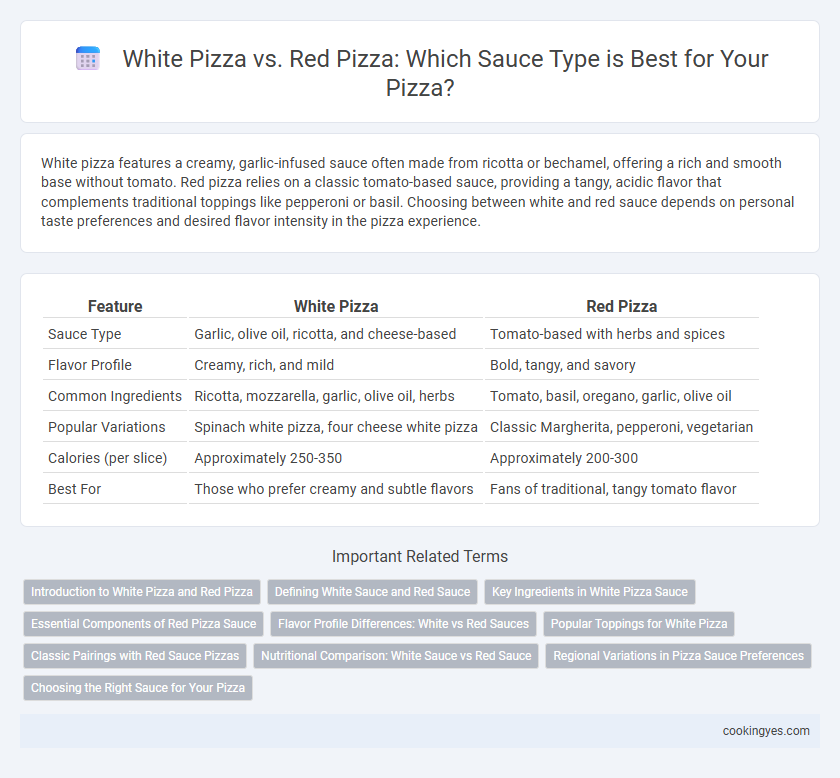White pizza features a creamy, garlic-infused sauce often made from ricotta or bechamel, offering a rich and smooth base without tomato. Red pizza relies on a classic tomato-based sauce, providing a tangy, acidic flavor that complements traditional toppings like pepperoni or basil. Choosing between white and red sauce depends on personal taste preferences and desired flavor intensity in the pizza experience.
Table of Comparison
| Feature | White Pizza | Red Pizza |
|---|---|---|
| Sauce Type | Garlic, olive oil, ricotta, and cheese-based | Tomato-based with herbs and spices |
| Flavor Profile | Creamy, rich, and mild | Bold, tangy, and savory |
| Common Ingredients | Ricotta, mozzarella, garlic, olive oil, herbs | Tomato, basil, oregano, garlic, olive oil |
| Popular Variations | Spinach white pizza, four cheese white pizza | Classic Margherita, pepperoni, vegetarian |
| Calories (per slice) | Approximately 250-350 | Approximately 200-300 |
| Best For | Those who prefer creamy and subtle flavors | Fans of traditional, tangy tomato flavor |
Introduction to White Pizza and Red Pizza
White pizza features a creamy base typically made from ricotta, mozzarella, and garlic instead of traditional tomato sauce, offering a rich and delicate flavor profile. Red pizza relies on a tangy tomato sauce made from crushed tomatoes, herbs, and spices, creating a classic, savory taste that complements various toppings. Choosing between white and red pizza sauces depends on preferred flavor intensity and texture, with white pizzas delivering a smooth, cheesy experience, while red pizzas emphasize bright, acidic notes.
Defining White Sauce and Red Sauce
White pizza features a creamy sauce typically made from ricotta, mozzarella, parmesan, garlic, and olive oil, offering a rich and smooth flavor profile without tomato. Red pizza utilizes a tomato-based sauce rich in crushed tomatoes, garlic, herbs, and olive oil, providing a tangy and robust taste with acidity that balances the cheese. Choosing between white and red sauce depends on desired taste, with white sauce delivering a buttery, less acidic experience and red sauce offering a classic, savory base.
Key Ingredients in White Pizza Sauce
White pizza sauce features key ingredients such as ricotta cheese, garlic, olive oil, and sometimes cream or Parmesan, offering a rich and creamy texture without tomato base. This sauce highlights subtle flavors from herbs like basil and oregano, creating a delicate contrast to the robust tomato sauce of red pizza. Unlike red pizza sauce, white sauce focuses on dairy and garlic, emphasizing smoothness and richness over acidity.
Essential Components of Red Pizza Sauce
Red pizza sauce is traditionally made from ripe tomatoes, olive oil, garlic, and a blend of herbs such as basil and oregano, creating a robust and tangy flavor that complements the pizza crust and toppings. The acidity of the tomatoes balances the richness of cheese and meats, enhancing the overall taste experience. This sauce serves as the essential base for classic pizzas like Margherita and pepperoni, providing moisture and depth to each bite.
Flavor Profile Differences: White vs Red Sauces
White pizza features a creamy garlic and ricotta-based sauce that emphasizes a rich, smooth texture with subtle herbaceous notes, offering a milder and more delicate flavor profile. Red pizza, with its tomato-based sauce, brings a bright, tangy, and slightly acidic taste accented by oregano, basil, and garlic, creating a more robust and traditional Italian flavor. These contrasting sauce types define the overall taste experience, making white pizza ideal for those seeking creamy indulgence and red pizza perfect for fans of classic, savory tanginess.
Popular Toppings for White Pizza
White pizza, characterized by its garlic and olive oil-based sauce, often features popular toppings such as ricotta cheese, spinach, and artichokes that complement its creamy texture. Unlike traditional red pizza, which uses tomato sauce, white pizza toppings highlight fresh, mild flavors like mushrooms, roasted garlic, and mozzarella. This sauce type allows for diverse ingredient combinations, offering a lighter, savory alternative favored by those seeking less acidity in their pizza experience.
Classic Pairings with Red Sauce Pizzas
Classic red sauce pizzas, such as Margherita and Pepperoni, rely on the rich, tangy tomato base to complement savory toppings like mozzarella and cured meats, enhancing their robust flavors. The acidity in red sauce balances fatty ingredients and adds depth, making it an ideal choice for traditional pizza styles. Red sauce pairs well with basil, oregano, and garlic, creating a complex flavor profile that defines many iconic pizzas.
Nutritional Comparison: White Sauce vs Red Sauce
White pizza sauce, often made with cream or cheese bases, typically contains higher calories, fats, and saturated fats compared to red pizza sauce, which is tomato-based and rich in antioxidants like lycopene and vitamin C. Red sauce provides beneficial dietary fiber and lower fat content, making it a nutritionally lighter option. White sauce offers more calcium and protein due to dairy ingredients but may contribute to increased cholesterol levels.
Regional Variations in Pizza Sauce Preferences
White pizza, often featuring a garlic and olive oil base or creamy ricotta sauce, is popular in regions like New York and parts of the Northeast United States, where lighter sauce alternatives emphasize cheese and herbs. Red pizza, characterized by tomato-based sauces seasoned with oregano and basil, dominates in traditional Italian-American and West Coast pizzerias, reflecting strong Mediterranean culinary influences. Regional variations in sauce preference highlight distinct cultural tastes, with white sauces favored for subtle, creamy flavors and red sauces preferred for their robust, tangy profiles.
Choosing the Right Sauce for Your Pizza
Choosing the right pizza sauce greatly influences flavor and texture, with white pizza featuring creamy ricotta or bechamel sauces, enhancing richness and subtlety, while red pizza uses traditional tomato-based sauces that bring acidity and zest. White sauce pairs well with toppings like garlic, spinach, and chicken, offering a smooth, savory profile, whereas red sauce complements classic ingredients such as mozzarella, pepperoni, and basil, providing a bold, tangy foundation. Understanding these distinctions helps tailor your pizza experience to preferred taste preferences and culinary creativity.
White pizza vs red pizza for sauce type Infographic

 cookingyes.com
cookingyes.com